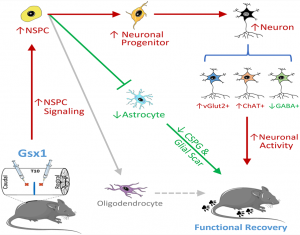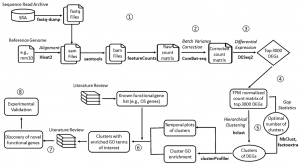Research
The goal of the Cai laboratory is to help develop better therapies and cures for injuries in the central nervous system, e.g., traumatic spinal cord injury.
Development of gene therapy for spinal cord injury
To restore function after spinal cord injury (SCI), it is necessary to repair and reconstruct the damaged local circuitry. Major hurdles in neural regeneration include a limited level of neurogenesis in the adult spinal cord, an inflammatory microenvironment that inhibits neurogenesis, axon regeneration, neuronal relay formation, and myelination at the injury site. Despite extensive research, neuroregeneration and functional recovery after SCI have still been extremely difficult. Neural stem/progenitor cells (NSPCs) persist in the adult spinal cord and represent a potential source of neural cells for wound healing and tissue regeneration after injury. SCI activates endogenous NSPCs that reside around the central canal in the ependymal region. However, adult NSPCs in the spinal cord largely differentiate into astrocytes and oligodendrocytes. Using mouse model and tissue engineering approaches, the Cai lab aims to determine the mechanisms underlying tissue damage repair and regeneration, and further to develop effective therapeutic strategies for SCI.

Functional gene discovery and characterization for retinal development and diseases
Topoisomerase II beta (Top2b) is an enzyme that catalyzes DNA strand passage reactions by moving one DNA duplex through a Top2b-linked transient double-strand break in another. During development, Top2b expression is found only in post-mitotic cells and not in proliferating cells, implicating its function in cell differentiation, maturation and maintenance instead of cell proliferation. TOP2B mutation is linked with global developmental delay and intellectual disability; possibly due to its requirement for the transcription elongation of long genes required for proper development. We demonstrate that Top2b deficiency affects developmentally regulated genes and causes defects in the retina. However, the affected cell types and the underlying the molecular changes have not been well characterized. Using conditional knockout mouse model, we study the role of Top2b in photoreceptor development and diseases.

Computational analysis of gene expression and regulation
We leverage existing knowledge and perform innovative computational analyses of the existing data, which allows the exploration of questions in above mentioned research areas.